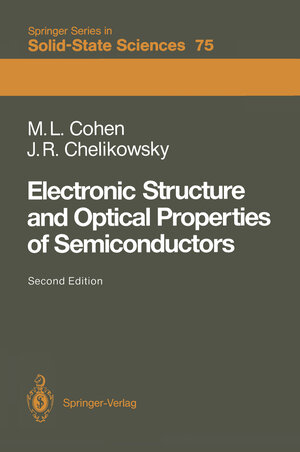
×
![Buchcover ISBN 9783540513919]()
Electronic Structure and Optical Properties of Semiconductors
von Marvin L. Cohen und James R. ChelikowskyInhaltsverzeichnis
- Theoretical Concepts and Methods.
- The One-Electron Model and Band Structure.
- Properties of En (k).
- Pseudopotentials.
- The Empirical Pseudopotential Method.
- Self-Consistent and Ab Initio Pseudopotentials.
- Response Functions and Density of States.
- Charge Density and Bonding.
- Low Energy Probes of Semiconductors.
- Band Gap Measurements.
- Excitonic Effects Near Band Edges.
- Cyclotron Resonance.
- Doping Effects in Semiconductors.
- Optical and Electronic Spectra of Semiconductors.
- Modulation Spectroscopy.
- High Energy Reflectivity Measurements.
- Photoemission Spectra of Semiconductors.
- Electron Energy Loss Spectroscopy for Semiconductors.
- High Energy Probes of Semiconductors: X-Rays.
- Crystal Structure Determinations.
- Charge Density Determinations Using X-Rays.
- Temperature Dependence of X-Ray Reflections.
- Diamond and Zinc-Blende Structure Semiconductors.
- Crystal Structure.
- The Electronic Structure of Silicon.
- The Electronic Structure of Germanium.
- The Electronic Structure of Gray Tin.
- Zinc-Blende Structure Semiconductors.
- The Electronic Structure of Gallium Arsenide.
- The Electronic Structure of Zinc Selenide.
- The Electronic Structure of Other III-V and II-VI Semiconductors.
- Wurtzite Structure Semiconductors.
- The Electronic Structure of Hexagonal Zinc Sulfide.
- The Electronic Structure of Hexagonal CdS and CdSe.
- The Electronic Structure of Hexagonal ZnO.
- Chalcopyrite Structure Semiconductors.
- IV-VI Semiconductors.
- Electronic Band Structure.
- Applications of the Electronic Band Structure.
- Triatomic, Layer, Chain, and Amorphous Models.
- References.
- Bibliography: Electronic Structure and Optical Properties of Semiconductors.
- B.1 Properties of Semiconductors.
- B.1.1 Charge Densities in Semiconductors.
- B.1.2 Chemical Trends and Bonding in Semiconductors.
- B.1.3 Compilation of Properties of Semiconductors.
- B.1.4 Electronic Structure of Semiconductors.
- B.1.5 Lattice Forces and Dynamics.
- B.1.6 Optical and Dielectric Properties of Solids.
- B.1.7 Photoemission and Electron Spectroscopies.
- B.1.8 Temperature and Pressure Effects in Semiconductors.
- B.2 General Semiconductor Articles.
- B.2.1 II-VI Semiconductors.
- B.2.2 III-V Semiconductors.
- B.2.3 IV-IV Semiconductors.
- B.2.4 IV-VI Semiconductors.
- B.3 Chalcopyrite Semiconductors.
- B.4 Properties of Specific Semiconductors.
- B.4.1 Aluminum Antimonide.
- B.4.2 Beryllium Oxide.
- B.4.3 Bismuth Triiodide.
- B.4.4 Cadmium Germanium Arsenide.
- B.4.5 Cadmium Oxide.
- B.4.6 Cadmium Selenide.
- B.4.7 Cadmium Sulphide.
- B.4.8 Cadmium Telluride.
- B.4.9 Carbon.
- B.4.10 Copper Bromide.
- B.4.11 Copper Chloride.
- B.4.12 Copper Iodide.
- B.4.13 Gallium Antimonide.
- B.4.14 Gallium Arsenide.
- B.4.15 Gallium Phosphide.
- B.4.16 Gallium Selenide.
- B.4.17 Gallium Sulphide.
- B.4.18 Gallium Telluride.
- B.4.19 Germanium.
- B.4.20 Germanium Telluride.
- B.4.21 Indium Antimonide.
- B.4.22 Indium Arsenide.
- B.4.23 Indium Phosphide.
- B.4.24 Lead Diiodide.
- B.4.25 Lead Selenide.
- B.4.26 Lead Sulphide.
- B.4.27 Lead Telluride.
- B.4.28 Magnesium Oxide.
- B.4.29 Magnesium Silicide.
- B.4.30 Mercury Selenide.
- B.4.31 Mercury Sulphide.
- B.4.32 Mercury Telluride.
- B.4.33 Selenium.
- B.4.34 Silicon.
- B.4.35 Silver Chloride.
- B.4.36 Silver Iodide.
- B.4.37 Tellurium.
- B.4.38 Tin.
- B.4.39 Tin Diselenide.
- B.4.40 Tin Disulphide.
- B.4.41 Tin Telluride.
- B.4.42 Zinc Germanium Phosphide.
- B.4.43 Zinc Oxide.
- B.4.44 Zinc Selenide.
- B.4.45 Zinc Sulphide.
- B.4.46 Zinc Telluride.




